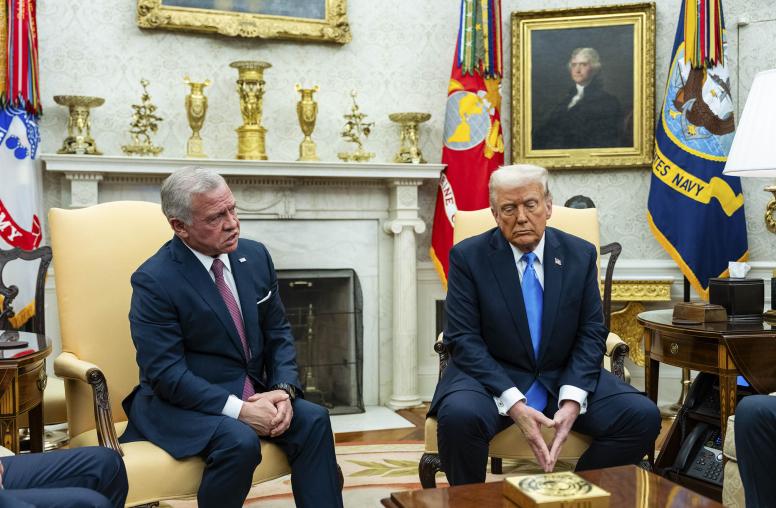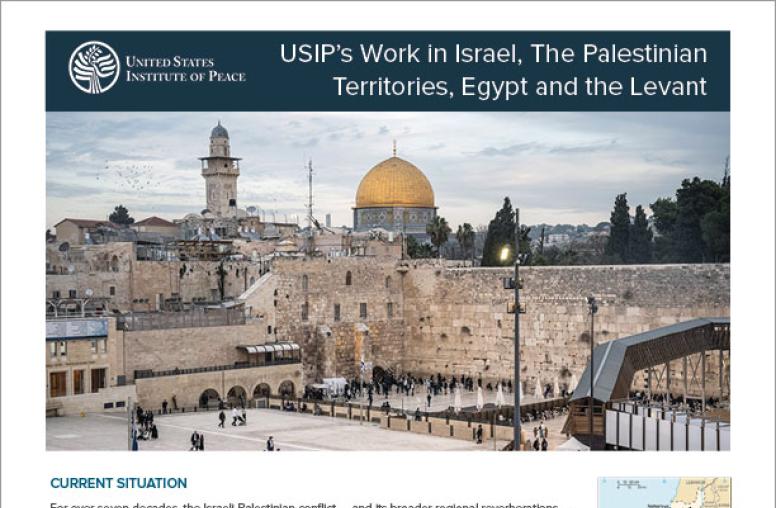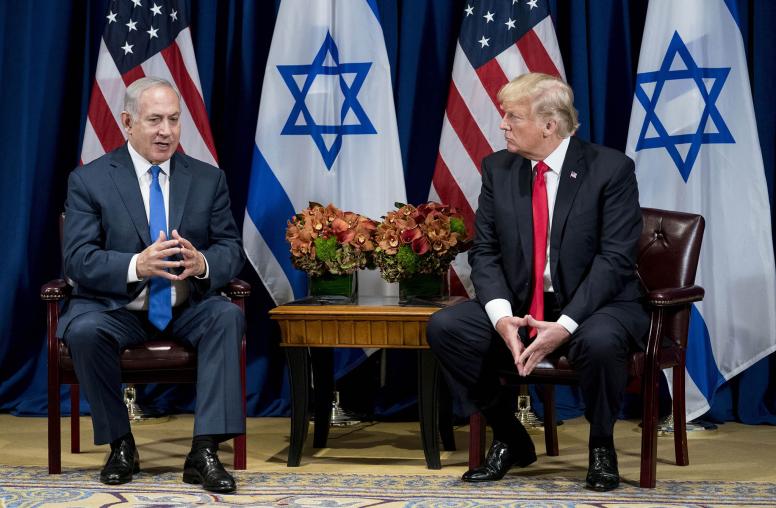Lucy Kurtzer-Ellenbogen on the Israeli-Palestinian Peace Plan
Discussing the Trump administration’s long-awaited peace plan, USIP’s Lucy Kurtzer-Ellenbogen says that although the proposal nods toward a two-state solution, the details leave one “hard pressed to see how it serves as a formula or basis for bringing both parties back to the table.”
On Peace is a weekly podcast sponsored by USIP and Sirius XM POTUS Ch. 124. Each week, USIP experts tackle the latest foreign policy issues from around the world.
Transcript
(Audio from news clip)
Tim Farley: That is Jared Kushner, son-in-law to the president, supposedly one of the key persons involved in putting together this president's... The president calls it a great deal of the century, Middle East peace plan. The question is, and we've heard similar rhetoric from the president as to whether or not this is actually going to work on the Palestinians. They've already said a definite no.
Tim Farley: But let's get into this. It's a little more complex than just what you hear play out with the bumper sticker phrases being tossed about. We're talking about the “deal of the century,” and joining us is Lucy Kurtzer-Ellenbogen, director of the Israeli-Palestinian Conflict Program at the United States Institute of Peace. The Twitter handle is @USIP. Lucy, welcome back. Thank you for being on POTUS today.
Lucy Kurtzer-Ellenbogen: Thank you, Tim. Thanks for having me.
Tim Farley: Much has been made about whether or not this was dead on arrival, whether the Palestinians should have been involved or not. Let's take it step-by-step if we can. First of all, what was it that was presented yesterday by the president?
Lucy Kurtzer-Ellenbogen: Well, what we saw yesterday was a plan that, as the president himself said, was certainly more detailed than anything that has been presented before on this. And it was a plan that, to the surprise of many, nodded to a type of two-state formula, which was not something that many had assumed it would do. It is a detailed blueprint when you go through the pages, offering some technical solutions for navigating questions that would certainly come up in trying to implement the vision that they have put out.
Lucy Kurtzer-Ellenbogen: But in its current form, one is hard pressed to see how it serves as a formula or a basis for bringing both parties back to the table. In essence, what was presented yesterday was presented as benefits that one side, the Israelis, were able to reap immediately following presentation to the plan, whereas the benefits that are laid out for the Palestinians, which is this vision of a state or a state at the end of a four year process, after which they have met a series of preconditions, that remains conditional on what happens going forward, whether or not they come to the table and again, whether they meet these conditions that were set out for them.
Tim Farley: So, the Israelis kind of get a signing bonus. What specific immediate benefits do they enjoy as a result of this?
Lucy Kurtzer-Ellenbogen: Well, where the plan leans heavily towards Israeli positions was in saying that Israel would get to apply sovereignty to annex all Jewish settlements that currently exist in the West Bank. And what was suggested yesterday was that that was something they could go ahead and start to work on immediately. There was a suggestion that a committee, a joint assumedly U.S.-Israel committee, would be set up to sort of go into what the details of that exactly would look like, but what it means and what was stipulated is that there would be no requirement for any settlement or settlers to move under the vision of this plan, and something that had not been assumed in previous formulas.
Tim Farley: Again, Lucy Kurtzer-Ellenbogen, director of the Israeli Palestinian Conflict Program at the United States Institute of Peace, joining us here on POTUS. So the Israelis say, "This is great," and Prime Minister Netanyahu congratulating the president, President Trump saying it's the deal of the century, the Palestinians are saying no… what is other reaction outside of this and how would that influence whether or not it is actually of greater significance?
Lucy Kurtzer-Ellenbogen: Well, that’s a great, that's an important question, and those reactions are unfolding. I think what you've seen overall is actually a reluctance by other key actors to push back too heavily yet on the plan. I think you've been seeing reactions ranging from a tepid welcome, in some cases, of the effort to, something that reaffirms long-held positions on the conflict— two-state— something that can be mutually negotiable, to at best, strongest. Again, we're talking about some actors here who've typically been a part of helping mediate these solutions along with the United States. You've had some sounding caution against unilateral actions being taken, specifically looking at the idea that Israel might go ahead and begin to annex. The strongest reaction that you've seen coming from key Arab allies in the Arab world has been Jordan's reaction, which affirmatively came out cautioning against unilateral actions, and this is not surprising.
Lucy Kurtzer-Ellenbogen: Jordan, perhaps, has the most to lose here and the most concern about what may play out over the coming weeks and months on this. But perhaps, surprisingly, and something interesting to watch is that some other Arab states including Saudi Arabia, the United Arab Emirates, Qatar, and to some extent Egypt, you've seen a cautious welcome of U.S. efforts to try to do something positive to bring the parties back to the table. And, actually, these states have come out and encouraged both parties, obviously including therefore the Palestinians, to come to the table and see this as a basis for negotiation.
Tim Farley: Lucy, I wonder, the last time we got maybe closer was under President Bill Clinton at the time. Yasser Arafat, the PLO leader, rejected the plan and that pretty much put the kibosh on it. I wonder, is the Palestinian authority in a position, the same kind of position of strength that it had at the time? In other words, are the partners equals and opposites, those in the negotiations, the Israelis and the Palestinians? Are they seen that way? Do they have that much strength? Give us a sense of the relative strengths of the two.
Lucy Kurtzer-Ellenbogen: No, look, there's a significant imbalance of the strength of the parties. The Palestinian leadership is in a very weak position, and in some sense what you've seen play out here is some calculations along these lines. I think embedded in this vision is an assumption that the Palestinians don't seem to have a lot of cards to play at this point. They are divided politically between a West Bank and a Gaza leadership. They have little legitimacy and both Hamas leadership in Gaza and the Fatah leadership in the West Bank have little legitimacy or popularity among their own people. And so they're really not coming at this or coming to this position of strength. Interestingly, perhaps ironically in the same way that we saw the lead up to this plan and the release this plan bring two Israeli political rivals together, Benny Gantz and Benjamin Netanyahu.
Lucy Kurtzer-Ellenbogen: What we've actually seen since yesterday is this plan, if nothing else, bring Hamas and Fatah together. They are reported to be meeting in a rare joint meeting in Ramallah on Tuesday to discuss reactions to the plan. But at this point in time, the Palestinians are not coming at this from a position of strength.
Tim Farley: One last question on this, Lucy, and then I know David Sanger, his analysis in the New York Times, two allies draw a map with voters in mind. This was the headline. It's essentially, he says, about two elections. Prime Minister Netanyahu is facing a challenge and trying to figure out exactly if he's going to get yet another turn at the wheel for the Israeli government. Of course, President Trump facing a reelection challenge in 2020 in November of this year. So it does, whether you agree or with that or not, but it does strike me that anybody who's involved in this is certainly not going to feel pressure to get something done before those elections are decided.
Lucy Kurtzer-Ellenbogen: Right. One certainly can't ignore the timing in that regard. And despite the fact that President Trump noted yesterday that peace should be above law, beyond politics, obviously domestic politics, all sides are front and center in the consideration of what will play out. Notable as well, that in Israel, there was yet a third election slated to come up on March 2nd which will, perhaps at this time, determine who will be the prime minister of Israel, which also constrains... This is now the third election they'll be having in a year. And of course, that will also constrain perhaps what Netanyahu is able to push through before that election on what we might see happen there by way of unilateral actions in response to the plan.
Tim Farley: I do appreciate your being here. Lucy, thanks so much for joining us on POTUS this morning.
Lucy Kurtzer-Ellenbogen: You're very welcome.
Tim Farley: Lucy Kurtzer-Ellenbogen, director of the Israeli Palestinian Conflict Program at the United States Institute of Peace, showing you why we need people like that to help us understand this is much more than just the simple slogans you're hearing tossed about in a coverage of something like this. The president calls it the deal of the century. It's not being accepted or at least received so graciously by the Palestinians. The Israelis are embracing, but it's a lot more than that. We'll have to continue to watch over time. The Twitter handle for Lucy, by the way, is @USIP.



